Text
A Japanese high court ruled Thursday the country's lack of legal recognition of same-sex marriage is unconstitutional, in a move likely to further mount pressure on the government to do more to protect sexual minorities.
The Sapporo High Court upheld the lower court's landmark verdict in 2021 that said non-recognition of same-sex marriage violates the right to equality protected under the Constitution but rejected a total of 6 million yen ($40,600) in damages sought by three same-sex couples in Hokkaido against the state for emotional distress.
The plaintiffs said they will appeal the ruling to the Supreme Court.
The ruling, the first by a high court among six lawsuits filed at five district courts questioning the current laws' unacceptance of same-sex marriage, said the provisions violate not only Article 14 on the right to equality but also Article 24, which says marriage shall be only on the mutual consent of "both sexes."
The court stated for the first time that Article 24 can be understood as also guaranteeing marriage between individuals of the same sexes.
The clause did not anticipate same-sex marriages when the Constitution was enacted but "it should be interpreted against the background where respect for individuals is more clearly considered," Presiding Judge Kiyofumi Saito said in handing down the ruling.
The ruling also said "there would be no disadvantage or harm" even if same-sex marriages are legalized, including in terms of social impact.
Feelings of discomfort or aversion toward same-sex marriages "are only due to sensuous, emotional reasons," the ruling said, adding those feelings could be resolved through promotion of public awareness about the unnecessity of treating same-sex couples differently.
Japan remains the only Group of Seven major industrialized country that has not legalized same-sex marriage or civil unions, despite growing pressure from the LGBT community and its supporters.
In the lawsuit, the government has argued that the Constitution presumes marriage is only between heterosexual couples.
In rejecting the plaintiffs' claims for damages, the court said, "It cannot be said that discussions at the Diet...regarding provisions not allowing same-sex marriage are clearly in violation of the Constitution."
One of the plaintiffs told a press conference in Sapporo that she was "encouraged by the forward-thinking" ruling.
At the district court level, courts have given different opinions regarding same-sex marriage, with Tokyo District Court becoming the latest to give a ruling on the issue earlier Thursday.
The Tokyo court said the lack of legal recognition of same-sex marriage in the country is in a state of unconstitutionality, reaching the same conclusion as Tokyo and Fukuoka district courts in 2022 and 2023, respectively.
Sapporo and Nagoya district courts have ruled that disallowing same-sex marriage was unconstitutional in 2021 and 2023, respectively, while the Osaka District Court said it was constitutional in 2022. Every court has dismissed compensation claims.
In the Tokyo District Court ruling Thursday, Presiding Judge Tomoyuki Tobisawa said the lack of legal arrangements similar to heterosexual marriages for same-sex couples was "a deprivation of a key part of their personal identity."
But Tobisawa concluded it did not amount to unconstitutionality at present, saying the Diet has "many options" to take action on the issue.
The eight plaintiffs, consisting of company employees and public servants in their 40s and 50s living in Tokyo, said legislative inaction on the matter has violated their rights and caused them emotional distress. They had sought 1 million yen each from the central government.
Japan's civil law and family registration law provisions are based on marriage between a man and a woman, and privileges resulting from matrimony, including inheritance rights, tax benefits and joint custody of children, are only granted to heterosexual couples.
Against that backdrop, an increasing number of municipalities have issued partnership certificates to make it easier for same-sex partners to enjoy some of the same public service benefits as heterosexual couples, although they are not legally binding.
22 notes
·
View notes
Text
By Luke Gentile
The FBI announced last week its recovery of at least 22 historical artifacts taken after the American victory at the Battle of Okinawa in World War II.
A deal to return the artifacts to the Government of Japan, Okinawa Prefecture, was arranged via the FBI, and a repatriation ceremony will be held after the artifacts return for the first time in nearly eight decades, according to a release from the FBI Boston Division.
Several artifacts date back to the 18th and 19th centuries and hold a place in the long history of Okinawa, including portraits, a hand-drawn map, pottery, and ceramics, the release noted.
“It’s incredibly gratifying when the FBI is able to recover precious cultural property that has been missing for almost 80 years,” Jodi Cohen, the special agent in charge of the FBI Boston Division, said.
“This case highlights the important role the public plays in recognizing and reporting possible stolen art. We’d like to thank the family from Massachusetts who did the right thing in reaching out to us and relinquishing these treasures so we could return them to the people of Okinawa,” Cohen said.
Multiple artifacts now returning to Okinawa were registered with the FBI’s National Stolen Art File in 2001 by the Okinawa Prefectural Board of Education, according to the release.
In 2023, the family of a late World War II veteran (who did not serve in the Pacific) discovered some of the valuable Asian art while they went through his personal items, and they found at least four of the works in the National Stolen Art File, according to the FBI.
“It’s an exciting moment when you watch the scrolls unfurl in front of you and you just witness history, and you witness something that hasn’t been seen by many people in a very long time,” Geoffrey Kelly, an FBI Boston special agent and Art Crime Team member, said.
“These artifacts are culturally significant, they’re important pieces of Japan’s identity. These were especially important because they were portraits of Okinawan kings dating back to the 18th, 19th centuries. This case really illustrates part of the work we do on the Art Crime Team. It’s not always about prosecutions and putting someone in jail. A lot of what we do is making sure stolen property gets back to its rightful owners even if it’s many generations down the road,” Kelly said.
Assisting the FBI in the return of the items was the Smithsonian Institute’s National Museum of Asian Art, according to the release.
“The FBI reached out, asked us for some help making sure they knew how to care for the works and that they had a safe place to store them while they worked out the repatriation details. It’s an honor to be able to help the works go back to their home,” Danielle Bennett, the head of collections management at the National Museum of Asian Art at the Smithsonian Institute, said.
You can see all of the recovered artifacts here.
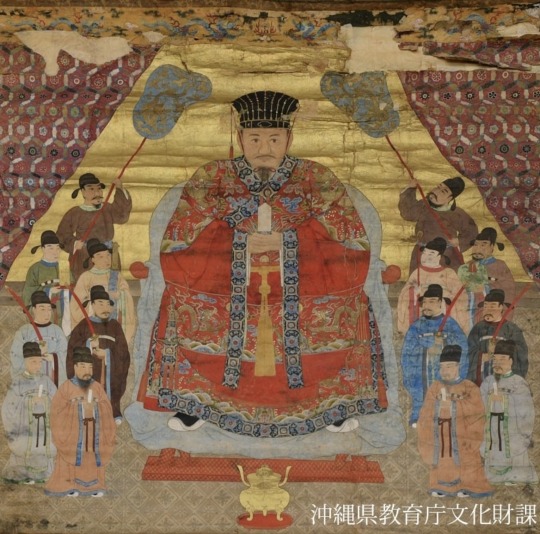
55 notes
·
View notes
Photo
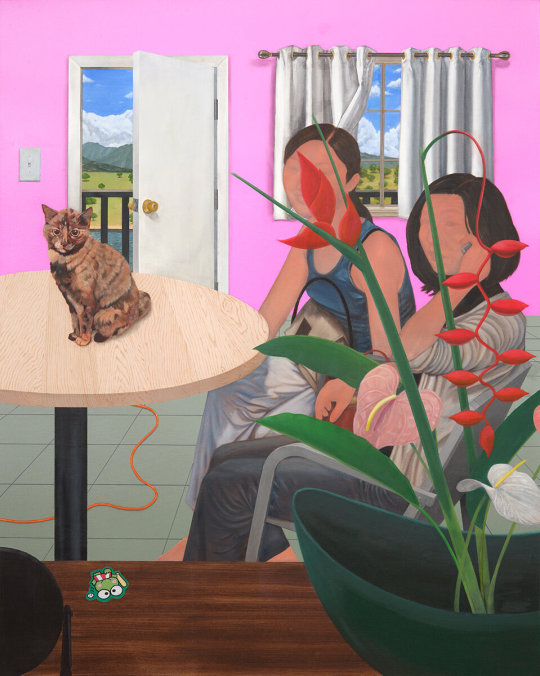
Shin S Yamazaki (@shinnyzak)
For lack of better words
Oil & acrylic on canvas
57 notes
·
View notes
Text
youtube
Today, I asked my friend's to share their experiences about being mixed race in Japan!
8 notes
·
View notes
Text
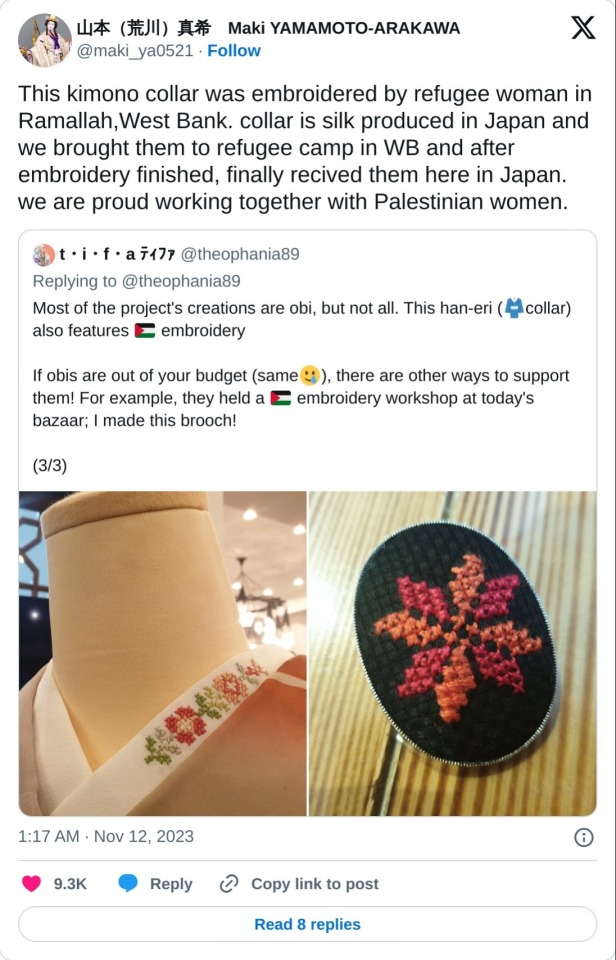
Beautiful combination of traditional Japanese clothing and traditional Palestinian patterns and tatreez/embroidery.

It is unknown if the refugee women who took part in this project are alive or dead...

156 notes
·
View notes
Text

“I became involved in a lot of human rights activities, which all stemmed from my sexual orientation as much as anything.”
Kiyoshi Kuromiya was a true hero who devoted his life to the struggle for social justice. Whether it’s was for civil right for Black Americans, the injustice of the Viet Nam War, Gay Rights, or effective treatment for people with AIDS - Kuromiya was there fighting for the cause.
Perhaps Kuromiya passion to fight oppression stems from the fact he was born at the World War II–era Japanese American internment camp (Heart Mountain, Wyoming).
At a very young age, Kuromiya was aware he was homosexual, although he didn’t know the term for it. At the age of 9 he found a copy of The Kinsey’s report on sexual behavior on open shelves in Public Library. It explain his nature to him. He soon “came out” to his parents. But later he was arrested for lewd behavior in a public park with a 16 year old teen boy. They were both detained and placed in juvenile hall for three days as punishment.
”… the judge or whatever he was told me and my parents that I was in danger of leading a lewd and immoral life.”
The arrest made Kuromiya feel like a criminal. The sense of shame forced him to keep his sexual identity a secret.
But those repressed feelings drove him to fight oppression. While attending the University of Pennsylvania in the early 1960s Kuromiya got involved with the Congress of Racial Equality (CORE) in their efforts to desegregate Maryland diners. Then in August 1963, he attended the March on Washington (along with 250,000 others) to demand justice for all citizens. At the end of the march Martin Luther King Jr. made his famous "I Have a Dream" speech.
That evening Kuromiya had the opportunity to meet King and other Civil Rights leaders. He formed a friendship with King and became his assistant. He participated in the March on Washington and in the voter registration campaign with Black Students in Montgomery, Alabama.
As part of his anti-war efforts Kuromiya designed the “Fuck the Draft” using the pseudonym Dirty Linen Corp.

As a gay man, Kuromiya also sought equality and freedom for other gay people. In 1965 he participated in the “Annual Reminder” at Independence Hall, one of the earliest rallies to remind the public that LGBT people did not have basic civil rights protections. He used the occasion to publicly announce he was Gay.
After the Stonewall riots in 1969, Kuromiya helped to organize the Philadelphia chapter of the Gay Liberation Front. With the advent of the AIDS crisis he was involved with the creation of ACT-UP and was the editor for the organization’s “Standard of Care”, the first medical treatment and competency guidelines for people living with HIV/AIDS.
Kuromiya was diagnosed with AIDS in 1989. Then he suffered a recurrence of lung cancer that he had survived in the 1970s. But that didn’t stop him. He insisted on receiving the most aggressive treatment for his cancer and it’s impact on his HIV drug regimen. And participated in every treatment decision. Kuromiya died of complications from cancer in May 2000.
“I'm a twenty-year metastatic lung cancer survivor and a fifteen-year AIDS survivor. And I really believe that activism is therapeutic.”
79 notes
·
View notes
Text
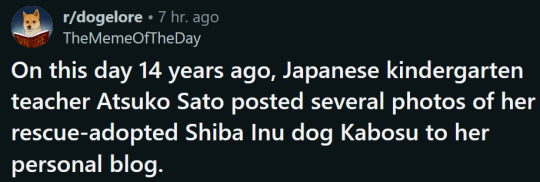
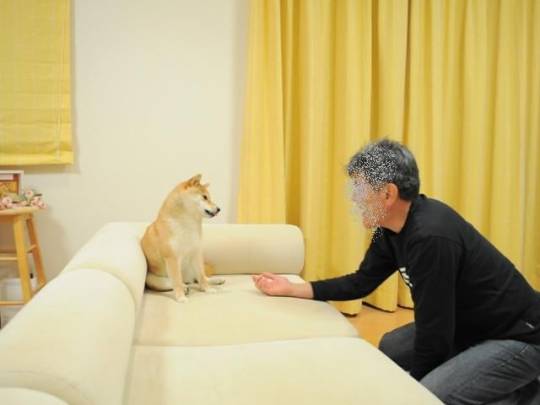





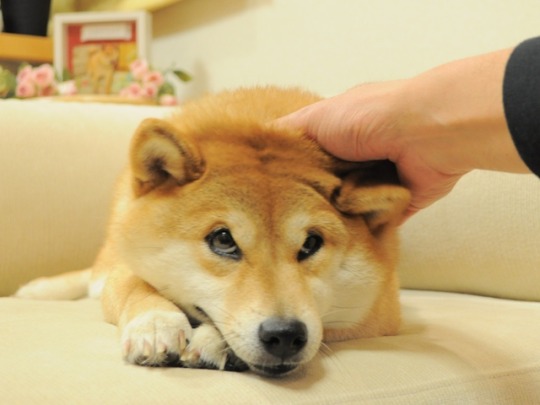

Original blog post
Le important day in meme history has arrived
104K notes
·
View notes
Text
Anyway this is why I keep saying that people refuse to be normal about the idea of mixed race people and interracial relationships and communities happening and creating children.
I am black and black only until it is convenient to call me white. And it doesn't matter that I'm also native because I'm too black to be native anyway. I've talked about being multi-racial and having even further racial mixing in my extended family since I made this blog in 2014 but that doesn't matter if any of my racial mix can be used as a weapon against me.
Y'all complain about the stereotype of the tragic mulatto without understanding why that stereotype exists in the first place.
9K notes
·
View notes
Text
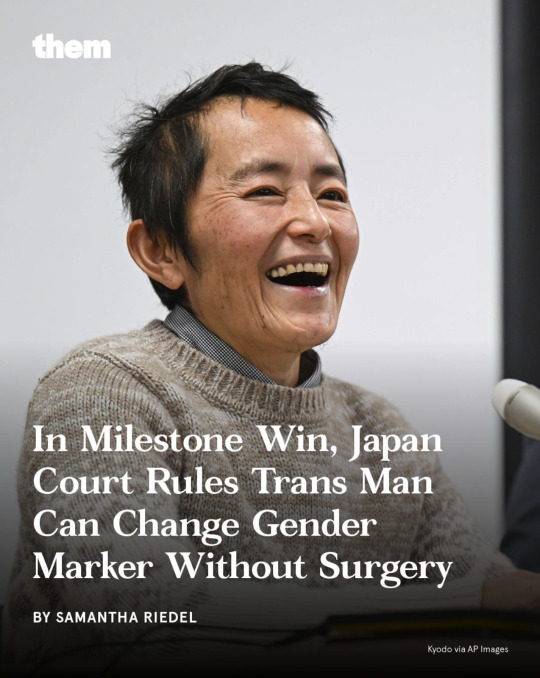
Japan Court Rules Trans Man Can Change Gender Marker Without Surgery
Them reports:
A Japanese court this week approved a transgender man’s legal gender change without first requiring sterilization, marking a major step forward for trans rights in the country.
Takakito Usui, 50, won recognition of his gender before the Okayama Family Court’s Tsuyama branch on Wednesday. “I want to thank my family. I feel a new life is beginning,” Usui, a farmer living in the rural Yamagata Prefecture, said at a press conference on Wednesday following the ruling.
Usui previously petitioned to change his legal gender in 2016, the paper noted, but was rejected because he had not been medically sterilized, as was then required under Japanese law. In October, Japan’s Supreme Court struck down the 2003 statute requiring trans people to be sterilized before obtaining legal recognition.
More here!
25K notes
·
View notes
Photo



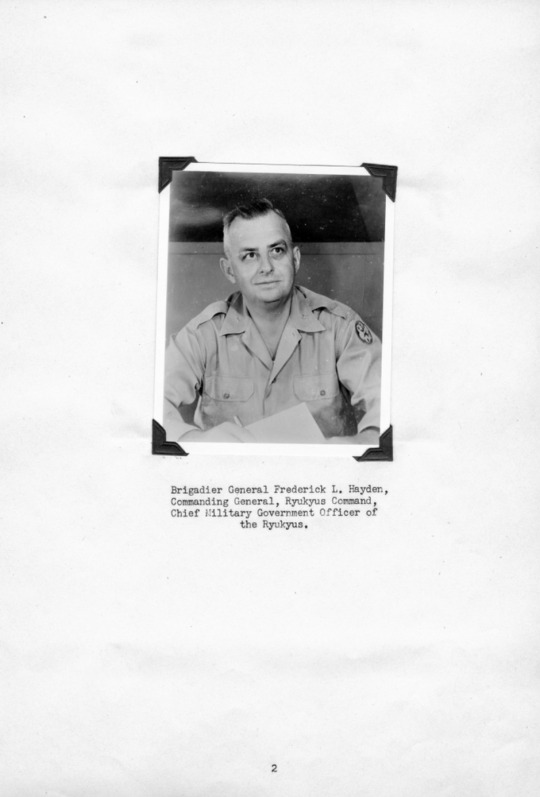
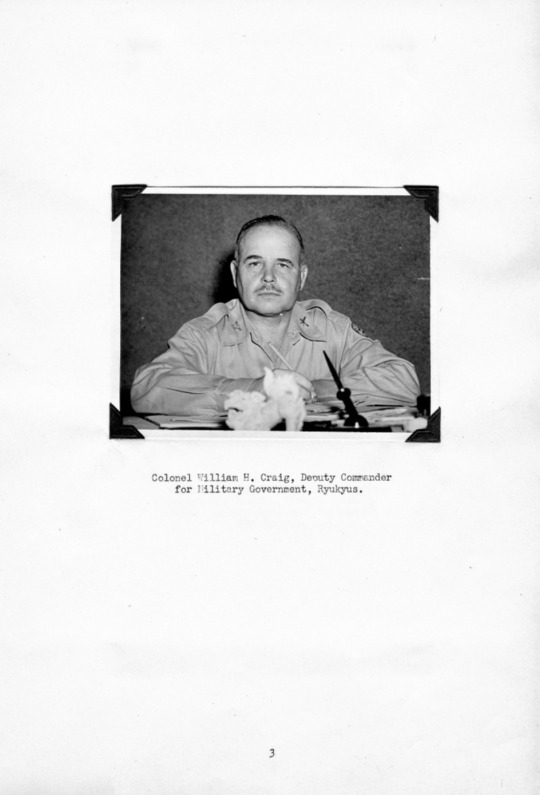
From: https://www.rememberingokinawa.com/page/1946_Repat_Report_pg1
Prior to the war many Ryukyuans lived and worked in Japan and other countries occupied or controlled by the Japanese. It was determined by the US military that for security and economic reasons that these people should be returned to the Ryukyu Islands. Repatriation actually started in Feb 1946 with the return of about 20,000 Ryukyuans from the Mariana Islands. The strain on Okinawa to accommodate them brought a halt to the program at that point. On 1 July 1946 the US Army took over control of the Military Government from the Navy and restarted the repatriation program with the first returnees due to arrive in August 1946 and all Ryukyuans to be repatriated by 26 Dec 1946.
Keep reading
14 notes
·
View notes
Text

George Matsusaburo Hibi - Coyotes Came Out of the Desert (1945)
2K notes
·
View notes
Text
Think reparations are impossible? The story of Japanese Americans proves otherwise
28 notes
·
View notes
Photo

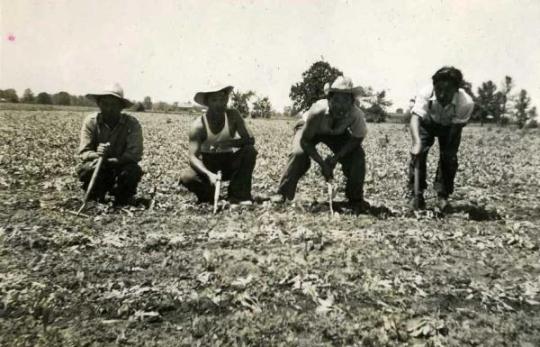
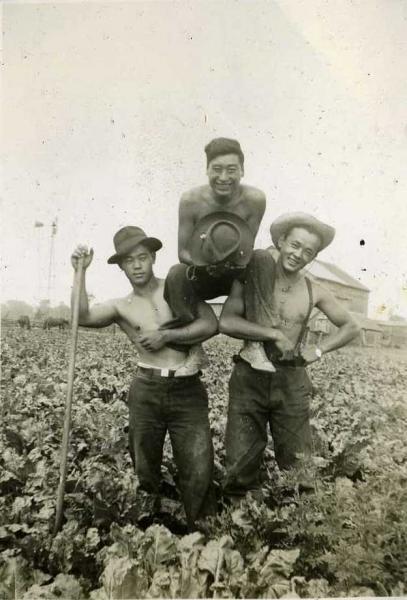

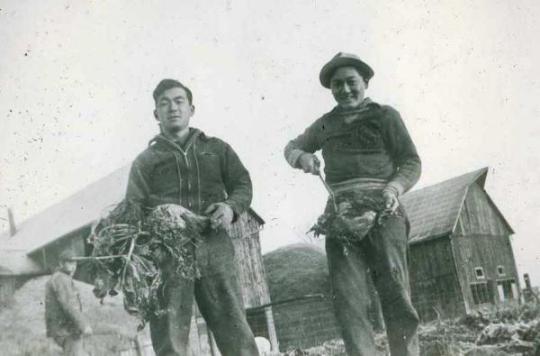
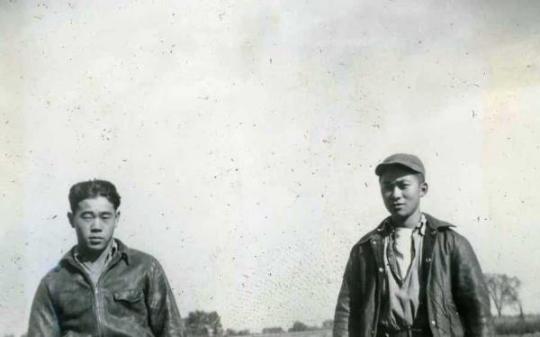
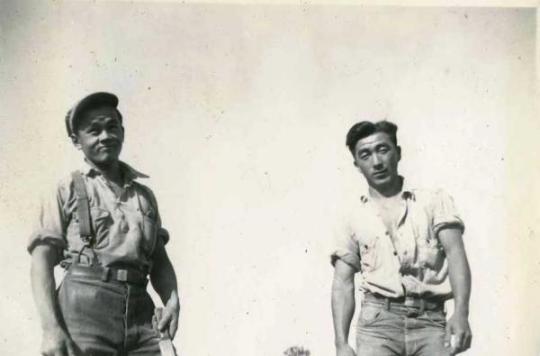
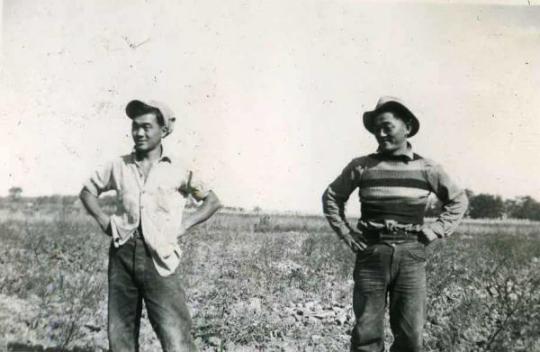
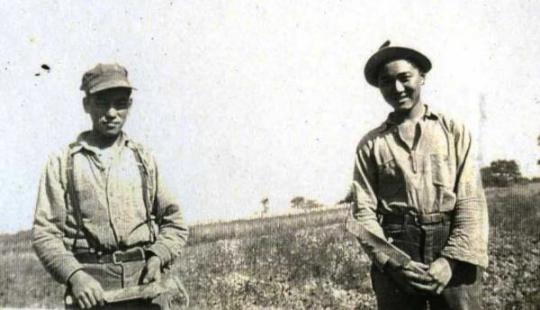
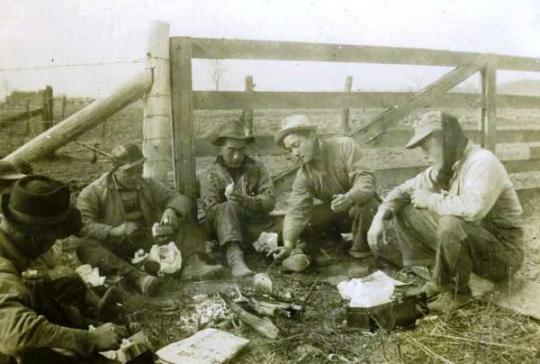
Photographs taken by Yon Shimizu, a Japanese-Canadian who was exiled from the west coast of Canada to Ontario during the second World War, along with hundreds of other Japanese-Canadian men. In 1942, he worked along with several dozen other men as a farm labourer with the Ontario Farm Service Force near Glencoe, equidistant from Sarnia, London and Chatham. These are photographs he took of the sugarbeet harvest, and were digitized from a DVD of Yon Shimizu’s scrapbook by the Southwestern Ontario Digital Archive. All dated 1942 though they definitely show a range of time during that summer and fall - final harvesting of sugarbeets is in late October or November, and the last photo shows the men huddling from the cold in November.
1) At Glencoe train station; the ‘49′ Gang, according to the caption. Left to right: Tsutomu “Stum” Shimizu, E. Ono, T. Okamoto, T. Kuwabara.
2) Blocking 48 Gang, that is, thinning or “blocking” the sugar beets; left to right: S. Miyashita, Y. Madokoro, S. Kawahara, J. Henmi.
3) “He-Men.” Left to right: B. Hoita, K. Goto, T. Hoita.
4) “Siesta Time!” T. Okamoto taking a siesta during the beet harvest.
5) “Block Busters!” Showing off some huge sugarbeets during the thinning (blocking) process.
6) Gang 5 “Toppers A-1” Butch Hoita and Stum Shimizu.
7) Gang 5 “Toppers A-1” Tommy Hoita and Tomo Okamoto.
8) Gang 5 “Toppers A-1” Stum Okamoto and Esao Ono.
9) Gang 5 “Toppers A-1” Tom Kuwabara and Yon Shimizu. Toppers defoliate the beets as close to harvesting as possible.
10) Lunch, Cold November Day
84 notes
·
View notes
Photo


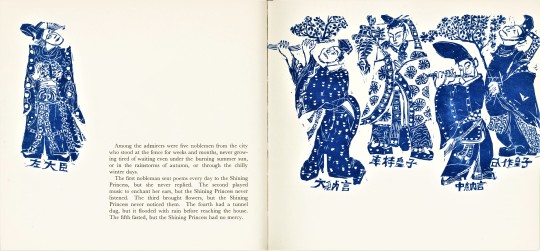

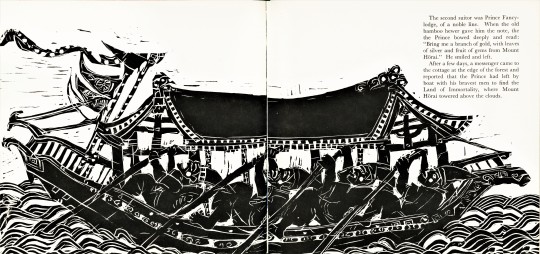

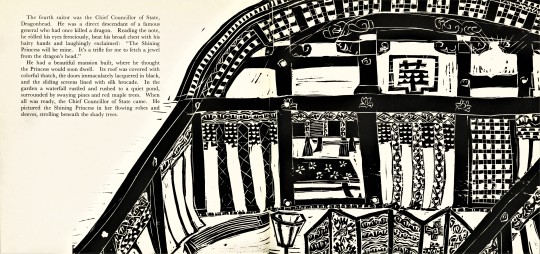

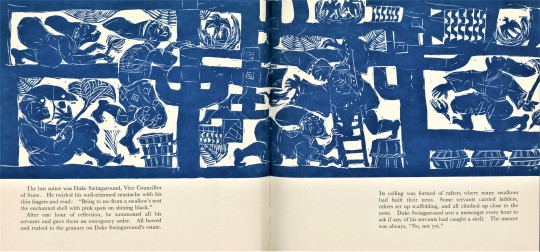
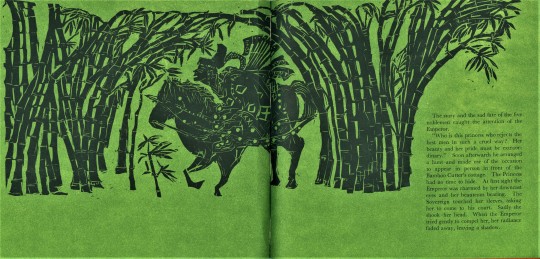
Staff Pick of the Week
My staff pick this week is the trade edition of The Tale of the Shining Princess by Japanese-born writer Hisako Matsubara (b.1935) and Japanese-Canadian artist-printmaker Naoko Matsubara (b.1937), published by Kodansha International LTD. Tokyo, Japan in 1966.
As a artist-printmaker and bookmaker who makes woodcuts, I am greatly inspired by Naoko’s prints. Naoko Matsubara’s work carries on traditions of Japanese printmaking while having its own contemporary flavor. Her woodcuts are ecstatic, they are vibrating with movement. Her use of bold shapes and the white line of the the carving tool makes the most of what woodcut has to offer. In the book form, the active images carry the reader’s eyes through the book space. Her use of negative space activates the page. Additionally, her woodcuts have translated beautifully to commercial printing.
The Matsubara sisters are daughters of a senior Shinto priest, and were raised in Kyoto. Both studied, lived, and worked in the United States. Hisako received her Master of Arts degree from Pennsylvania State College, moving to Germany where she continued her studies and became a prominent writer, publishing her work in Japanese, English, and German. In the 1980s she moved back to the United States, this time to California where she worked at Stanford University.
Naoko received her Master of Fine Arts from Carnegie Institute of Technology in Pittsburgh, now Carnegie Mellon University. After her studies she traveled across Europe and Asia. She returned to the United States and became the personal assistant to the artist and wood engraver Fritz Eichenberg, an artist who has been featured many times on our blog. Naoko taught at Pratt University in New York and at the University of Rohde Island. She also lived in Cambridge, Massachusetts for a time. Naoko is currently living and working in Canada in Oakville, Ontario, where she continues to work and exhibit nationally.
The work of both Hisako and Naoko have had great influence inside the United States and around the world. So lets celebrate their accomplishments!
This book has end sheets of mulberry paper with inclusions of Bamboo leaves, the cover is a red textured paper with a gold stamped design by Naoko.
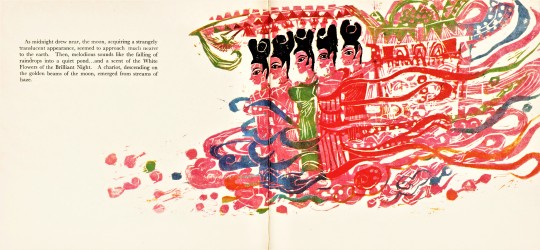


View some of our other AAPI selections for this month.
View our other Staff Picks.
- Teddy, Special Collections Graduate Intern
413 notes
·
View notes
Text
Kazue Togasaki
Dr. Kazue Togasaki was born in 1897 in San Francisco, California. Dr. Togasaki received her medical degree in Philadelphia in 1933, and returned to San Francisco, where she opened her own practice. After the bombing of Pearl Harbor, Dr. Togasaki was one of more than 100,000 Japanese Americans sent to internment camps. She was placed in an "assembly center", an interim holding facility with poor conditions. At the Tanforan Assembly Center, Dr. Togasaki set up the medical facilities and led other healthcare professionals. In her first month, she delivered more than 50 babies. She provided care at every facility she was sent to thereafter. Dr. Togasaki continued to serve her community for 40 years after she was released. Over the course of her career, she delivered more than 10,000 babies.
Dr. Kazue Togasaki died in 1992 at the age of 95.
23 notes
·
View notes
